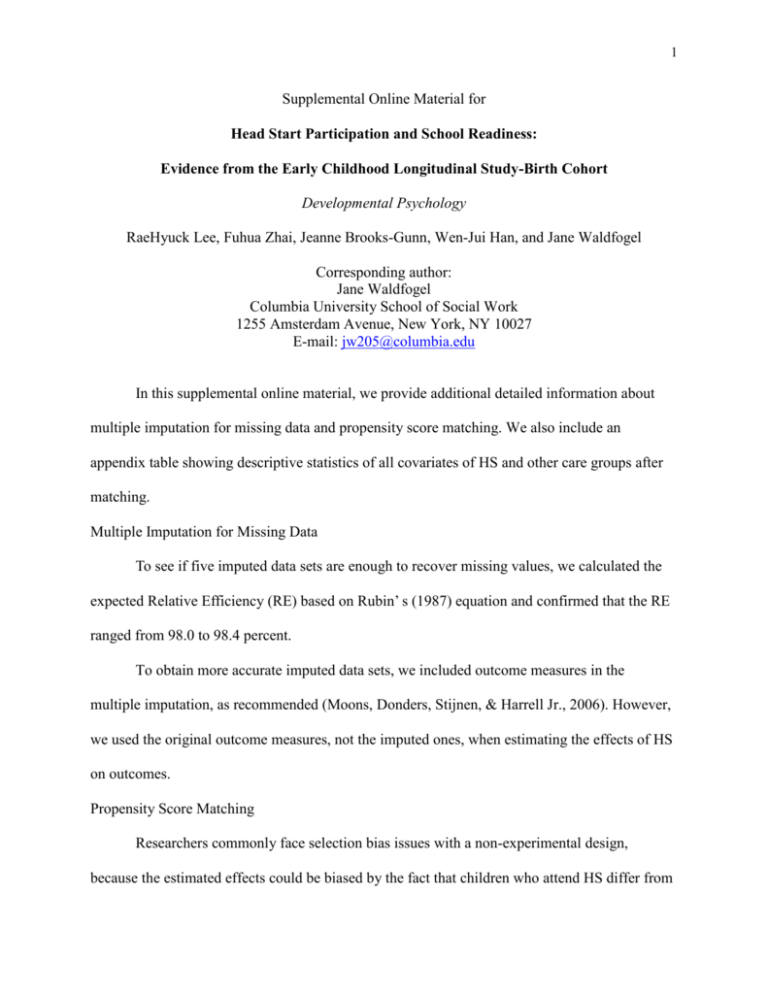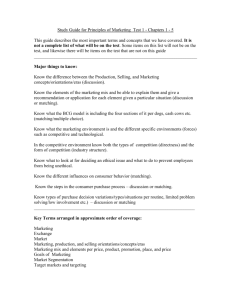DEV-DEV2-Waldfogel20111243-RR
advertisement

1 Supplemental Online Material for Head Start Participation and School Readiness: Evidence from the Early Childhood Longitudinal Study-Birth Cohort Developmental Psychology RaeHyuck Lee, Fuhua Zhai, Jeanne Brooks-Gunn, Wen-Jui Han, and Jane Waldfogel Corresponding author: Jane Waldfogel Columbia University School of Social Work 1255 Amsterdam Avenue, New York, NY 10027 E-mail: jw205@columbia.edu In this supplemental online material, we provide additional detailed information about multiple imputation for missing data and propensity score matching. We also include an appendix table showing descriptive statistics of all covariates of HS and other care groups after matching. Multiple Imputation for Missing Data To see if five imputed data sets are enough to recover missing values, we calculated the expected Relative Efficiency (RE) based on Rubin’ s (1987) equation and confirmed that the RE ranged from 98.0 to 98.4 percent. To obtain more accurate imputed data sets, we included outcome measures in the multiple imputation, as recommended (Moons, Donders, Stijnen, & Harrell Jr., 2006). However, we used the original outcome measures, not the imputed ones, when estimating the effects of HS on outcomes. Propensity Score Matching Researchers commonly face selection bias issues with a non-experimental design, because the estimated effects could be biased by the fact that children who attend HS differ from 2 children who do not participate (i.e., the poorest of the poor are likely to attend HS) (Gormley, Phillips, Adelstein, & Shaw, 2010; Schnur, Brooks-Gunn, & Shipman, 1992). Indeed, studies have shown that HS participants are strongly negatively selected and without adjusting for this selection bias, effects of HS could be masked (Currie & Thomas, 1995). We used a radius matching method with a caliper, which is beneficial in that it uses not only the single nearest neighbor within each caliper but all of the control units within the caliper, allowing for the use of additional comparison units when better matches are possible (Dehejia & Wahba, 2002). Radius matching with a caliper achieved better balance than alternative matching methods (such as nearest neighbor matching). Following Rosenbaum and Rubin (1985), we set a caliper at 0.01, which was smaller than 0.25 times a standard deviation of the predicted propensity scores. Whether propensity score matching procedures are successful can be tested by comparing the extent of balance and overlap of the propensity scores of the treatment and comparison groups (Dehejia & Wahba, 2002; Gibson-Davis & Foster, 2006). Initially, the propensity scores after matching in specific comparisons of HS with other non-parental care and pre-K were unbalanced in several covariates; to address this issue, we added various interaction terms into the propensity score matching procedure and achieved balance in all covariates. For the comparison of HS and other non-parental care, we obtained perfect balance by including interaction terms between whether a child was a twin and 1) mother’s education, 2) family income at the 9-month wave, 3) family income at the 2-year wave, and 4) region of country. For the comparison of HS with pre-K, we achieved the best balance after including interaction terms between region of country and 1) maternal employment at the 2year wave, 2) family income at the 9-month wave, 3) family income at the 2-year wave, and 4) 3 child race/ethnicity. We examined the distributions of propensity scores between the matched treatment and comparison groups in each comparison to see whether both groups in each comparison had enough common support regions. In all of the five imputed data sets, the distributions in comparisons of HS with parental care, other non-parental care, and pre-K were roughly symmetric. The distribution of the comparison group in the comparison of HS with other centerbased care was skewed to the left, but it also showed enough overlap (results are available from the authors upon request). 4 REFERENCES Currie, J., & Thomas, D. (1995). Does Head Start make a difference? American Economic Review, 85, 341-364. Dehejia, R. H., & Wahba, S. (2002). Propensity score-matching methods for nonexperimental causal studies. Review of Economics and Statistics, 84(1), 151-161. Gibson-Davis, C., & Foster, E. (2006). A cautionary tale: Using propensity scores to estimate the effect of Food Stamps on food insecurity. Social Service Review, 80(1), 93-126. Gormley, W. T., Phillips, D., Adelstein, S., & Shaw, C. (2010). Head Start's comparative advantage: Myth or reality? Policy Studies Journal Volume, 38(3), 397-418. Rosenbaum, P. R., & Rubin, D. B. (1985). Constructing a control group using multivariate matched sampling methods that incorporate the propensity score. American Statistician, 39(1), 33-38. Rubin, D. (1987). Multiple imputation for nonresponse in surveys. New York: John Wiley & Sons. Schnur, E. S., Brooks-Gunn, J., & Shipman, V. (1992). Who attends programs serving poor children?: The case of Head Start attendees and non-attendees. Journal of Applied Developmental Psychology, 13, 405-421. 5 Table A Descriptive Statistics of Head Start and Other Specific Care Arrangements after Matching Other centerPre-K based care after after HS matching matching (n ≈ 1,150) (n ≈ 1,000) (n ≈ 2,700) Variable M SD M SD M SD Child care arrangements 9-months Parental care 0.51 0.50 0.50 0.50 0.47 0.50 Relative care 0.31 0.46 0.33 0.47 0.32 0.47 Non-relative care 0.10 0.30 0.11 0.31 0.13 0.34 Center-based care 0.08 0.26 0.06 0.25 0.08 0.28 2-years Parental care 0.52 0.50 0.49 0.50 0.46 0.50 Relative care 0.24 0.43 0.28 0.45 0.26 0.44 Non-relative care 0.10 0.30 0.11 0.35 0.13 0.34 Center-based care 0.14 0.35 0.12 0.33 0.15 0.36 Child characteristics Boys 0.50 0.50 0.51 0.50 0.48 0.50 Age in months at 9-months 10.52 1.92 10.51 1.96 10.45 1.92 Race/ethnicity at 9-months Non-Hispanic White 0.21 0.40 0.19 0.39 0.21 0.41 Non-Hispanic Black 0.29 0.46 0.33 0.47 0.28 0.45 Hispanic 0.28 0.45 0.30 0.46 0.30 0.46 Non-Hispanic Asian 0.04 0.20 0.03 0.18 0.06 0.23 Other 0.18 0.38 0.14 0.35 0.15 0.35 Low birth weight at birth 0.25 0.44 0.26 0.44 0.26 0.44 Prematurity at birth 0.28 0.45 0.30 0.46 0.29 0.45 Multiple birth at birth 0.16 0.37 0.17 0.38 0.18 0.38 Breast-feeding at 9-months None 0.45 0.50 0.47 0.50 0.42 0.49 Other nonparental care after matching (n ≈ 600) M SD Parental care after matching (n ≈ 1,250) M SD 0.49 0.29 0.11 0.10 0.50 0.45 0.32 0.31 0.54 0.31 0.10 0.06 0.50 0.46 0.29 0.23 0.51 0.24 0.09 0.15 0.50 0.43 0.29 0.36 0.55 0.26 0.09 0.10 0.50 0.44 0.29 0.30 0.51 10.48 0.50 1.82 0.49 10.56 0.50 2.07 0.24 0.24 0.29 0.04 0.19 0.27 0.30 0.16 0.43 0.43 0.45 0.20 0.39 0.46 0.46 0.37 0.22 0.25 0.31 0.05 0.17 0.26 0.27 0.16 0.41 0.43 0.46 0.22 0.38 0.44 0.45 0.37 0.45 0.50 0.43 0.50 6 <3 months 3~6 months 7 months plus Number of siblings at 9months No sibling One Two or more Health status at 2-years Poor/Fair Good Very good Excellent Maternal characteristics Age at birth Mom lived with bio-mother until 16 Mom lived with bio-father until 16 Married at birth Depression at 9-months Employment status at 2-years Not working Full-time Part-time Foreign-born English is primary home language at 2-years Health status at 2-years Poor/Fair Good Very good Excellent Parenting behaviors KIDI at 9-months Cognitively stimulating activities at 2-years Having sleeping routines at 2-years 0.24 0.43 0.16 0.37 0.15 0.35 0.24 0.17 0.12 0.43 0.37 0.33 0.26 0.20 0.13 0.44 0.40 0.34 0.27 0.16 0.12 0.44 0.37 0.33 0.24 0.16 0.17 0.43 0.37 0.37 0.38 0.49 0.29 0.46 0.32 0.47 0.39 0.26 0.35 0.49 0.44 0.48 0.37 0.28 0.35 0.48 0.45 0.48 0.35 0.36 0.28 0.48 0.48 0.45 0.35 0.27 0.38 0.48 0.45 0.49 0.04 0.14 0.29 0.54 0.19 0.34 0.45 0.50 0.07 0.13 0.30 0.50 0.25 0.33 0.46 0.50 0.07 0.12 0.31 0.50 0.25 0.32 0.46 0.50 0.04 0.13 0.27 0.55 0.19 0.34 0.45 0.50 0.04 0.15 0.30 0.51 0.20 0.36 0.46 0.50 25.16 0.79 0.50 0.44 0.54 6.10 0.41 0.50 0.50 0.52 25.00 0.84 0.50 0.41 0.56 6.21 0.36 0.50 0.49 0.54 25.14 0.82 0.51 0.49 0.54 5.71 0.38 0.50 0.49 0.55 24.24 0.79 0.45 0.42 0.55 6.32 0.40 0.50 0.49 0.51 25.23 0.80 0.49 0.48 0.55 6.16 0.40 0.50 0.50 0.51 0.52 0.33 0.15 0.25 0.77 0.50 0.47 0.36 0.43 0.42 0.51 0.34 0.15 0.27 0.78 0.50 0.47 0.36 0.44 0.41 0.49 0.38 0.14 0.27 0.75 0.50 0.48 0.34 0.44 0.43 0.50 0.34 0.16 0.23 0.80 0.50 0.47 0.36 0.42 0.40 0.55 0.30 0.15 0.29 0.73 0.50 0.46 0.36 0.46 0.44 0.13 0.30 0.30 0.26 0.34 0.46 0.46 0.44 0.11 0.35 0.30 0.24 0.31 0.48 0.46 0.43 0.15 0.29 0.32 0.23 0.36 0.46 0.47 0.42 0.10 0.32 0.31 0.27 0.30 0.47 0.46 0.45 0.13 0.29 0.34 0.24 0.34 0.46 0.47 0.43 5.81 2.08 8.81 2.08 0.79 0.41 6.01 8.75 0.82 1.93 2.11 0.39 6.01 8.95 0.80 2.17 2.03 0.40 6.06 8.76 0.83 1.95 1.94 0.38 5.79 8.89 0.78 2.06 2.04 0.42 7 Eating dinner together per week at 2-years 5.29 2.30 5.02 2.38 5.16 2.36 5.14 2.42 5.05 2.41 No spanking at 2-years 0.58 0.49 0.55 0.50 0.56 0.50 0.55 0.50 0.62 0.49 Family characteristics Parent's education at birth Below high school (0-11) 0.23 0.42 0.22 0.41 0.20 0.40 0.23 0.42 0.25 0.43 High school (12) 0.38 0.49 0.38 0.49 0.42 0.49 0.33 0.49 0.37 0.48 Some college (13-15) 0.31 0.46 0.31 0.46 0.31 0.46 0.38 0.47 0.30 0.46 Above college (16+) 0.08 0.27 0.09 0.29 0.07 0.26 0.07 0.25 0.08 0.27 Parental occupational prestige at 9 months 1.66 2.07 1.75 2.12 1.88 2.08 1.74 2.14 1.57 2.06 Family income at 9-months $0-$20000 0.49 0.50 0.46 0.50 0.46 0.50 0.46 0.50 0.50 0.50 $20001-$35000 0.31 0.46 0.31 0.46 0.31 0.46 0.31 0.46 0.28 0.45 $35001-$50000 0.16 0.37 0.18 0.39 0.17 0.38 0.16 0.38 0.16 0.37 $50001+ 0.04 0.20 0.05 0.21 0.06 0.24 0.07 0.25 0.06 0.23 Family income at 2-years $0-$20000 0.47 0.50 0.41 0.49 0.42 0.49 0.45 0.50 0.45 0.50 $20001-$35000 0.30 0.46 0.32 0.47 0.30 0.46 0.30 0.46 0.28 0.45 $35001-$50000 0.19 0.39 0.21 0.41 0.22 0.42 0.18 0.39 0.22 0.41 $50001+ 0.05 0.22 0.06 0.23 0.06 0.23 0.06 0.24 0.05 0.22 Lived in urban area at 2-years 0.76 0.43 0.80 0.40 0.80 0.40 0.83 0.37 0.79 0.40 Region of country at 2-years Northeast 0.13 0.34 0.16 0.37 0.14 0.35 0.15 0.36 0.13 0.33 Midwest 0.23 0.42 0.21 0.40 0.21 0.41 0.22 0.42 0.20 0.40 South 0.39 0.49 0.44 0.50 0.39 0.49 0.36 0.48 0.37 0.48 West 0.25 0.43 0.19 0.39 0.26 0.44 0.27 0.44 0.30 0.46 Mom or child received WIC at 2-years 0.73 0.44 0.70 0.46 0.69 0.46 0.72 0.45 0.70 0.46 Family members received FS 2-years 0.44 0.50 0.41 0.49 0.41 0.49 0.40 0.49 0.43 0.49 Family members received TANF at 2-years 0.15 0.36 0.12 0.33 0.13 0.35 0.19 0.39 0.16 0.37 Note. Descriptive statistics of other specific care arrangements after matching were reported from the best matched one of the five imputed data sets. Sample sizes were rounded to the nearest 50, due to IES reporting rules. All numbers in the column for HS were slightly different with those in the same column in Table 1 because these numbers were not weighted to be compared with those of each comparison group after matching. Two-tailed t tests were conducted to compare means between HS participants and other children who belonged to each specific type of care arrangement after propensity score matching; no significant differences were 8 found. WIC = Special Supplemental Nutrition Program for Women, Infants, and Children; FS = Food Stamp Program; TANF = Temporary Assistance for Needy Families.







